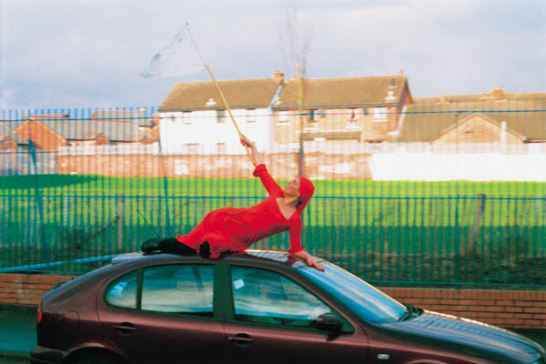| Umělec 2002/4 >> Lady in Red | Просмотр всех номеров | ||||||||||||
|
|||||||||||||
Lady in RedUmělec 2002/401.04.2002 Martin Zet | news | en cs |
|||||||||||||
|
This is one of those events about which it is not easy to say: I like it. The “Peace Wall” area, close to Falls Street in Belfast: a system of fences and gates. Fences dividing “problematic neighborhoods” Fences showing that the estimated amount of hatred came up shorter than expected. The original height of the fences was not sufficient and it became necessary to raise the upper edge, to build another level, and then another. In the safety shadows of the fences there are lines of small houses, little concrete gardens, little attempts to build intimate shelters, private paradises. If there is a burnt out building next door, you must not think that this is the real thing. You must forget about its very existence and about the reason for and the context of its presence.
The lady in red moves through the area. Is she dancing or weaving along? Falling, getting dirty, theatrical gestures, poses, stopping cars in the gate, sometimes almost getting hit by them. It’s physically unpleasant to watch this, to passively participate in it, to be one of the observing crowd. When somebody wants to leave she doesn’t let him. It’s physically unpleasant when she speaks to drivers, enters private gardens, doors. Explains something to people. Sad. Unbearable. And anyway she is no longer a girl. This is a women, her clothes a light red in a region where all the colors are fucked up with political meanings. Red communists, orange unionists, green republicans, etc. In a region where mural paintings on both sides adopt hermetic symbols for political purposes. Where each side identifies with the opposite side from the Israeli-Palestinian conflict. Unionists (Protestants) with the Jewish side; Republicans (Catholics) with the Palestinians. The red cloth, the white flag. Why is it white, then? Peace, surrender? Nothing is just as it is. Everything has some additional meaning. And this aesthetically rich, beautiful spectacle shows many layers of poverty under the grace. Shows humanity separated from sex. She is just a human conscience playing woman. The symbol of woman, according to a cheap, false, but for now the only available, screenplay. It’s unbearable, but fascinating. The experience you dream to forget, but you can not. Adina says: “Each time I am invited to perform Disposition, I readjust it to its new location: Kibbutz Nachshon (Israel), Hong Kong, Quimper (France), Helsinki (Finland), Toronto (Canada), Belfast (Ireland). This work is a challenge and a fascinating one for me to create. Its evolvement begins with my receiving maps of various locations of neighborhoods, and their descriptions by my hosts. I would read into the nature of the verbal description of the various locations sent to me. I would find an interest in understanding why a location is specified as a ‘good neighborhood,’ generally speaking, or for my performance-work, and of a specific landmark as being ‘interesting.’ After having chosen the neighborhood I would review its map in order to get an idea of road patterns to reflect something of the nature of the area. Of course, any neighborhood would do, but a neighborhood whose ‘Social-History’ is exemplary or which brings ‘Municipal Pride’ so naturally arouses my special interest. So, when I finally arrive at the chosen neighborhood I observe it for a few days: the human activities around the public and private buildings, gardens. The roads, their width, the landscape alongside them, traffic, drivers, the manner of driving. The performance takes place as a journey, a walk, on a chosen venue in an urban space; through traffic, road crossings, land marks... I think the conception of this work was confirmed while I was observing the Yugoslavian war on television in Tel-Aviv (how ironic). The images of population movement, not armies, on the roads. The disruption of boarders and the contours of home, family and all ideologies intrigue me. The woman in my performance envisions her boundaries in scraps of stories about homes and neighborhoods she has lived in, visual, film-like images she creates as ‘woman in landscape,’ ‘woman with vehicle,’ ‘woman with flag’ and situations provoked between herself and the audience as leader and follower. I am intrigued by this power. Actually, I am agitated by the premonition of a basic primitive drive that is creation and destruction in one. I suppose this work is another one of my attempts to question what appears as the inevitability of destruction in the process of construction.” M. Z., December 30, 2002 in Libušín Adina Bar’On’s performance Disposition for fiX02, Belfast’s Festival of Performance and Time-based Art, December 2002 Photographs by Martin Zet
01.04.2002
Рекомендуемые статьи
|
|||||||||||||








Комментарии
Статья не была прокомментированаДобавить новый комментарий